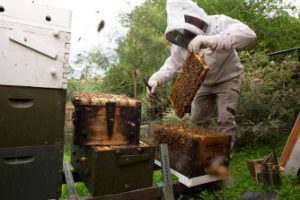Chemical concerns after mass bee kill in Australian Almond Pollination
By Cara Waters
Geelong beekeeper John Edmonds used to take his bee hives up to the Sunraysia region on the Murray River every winter to help pollinate the almond farms.
It’s a well-travelled route for beekeepers, with over 277,000 hives placed on almond orchards across Australia during blossom season from August to September each year.
However, Mr Edmonds has kept his bees at home for the past five years, deterred by the low prices paid by almond farmers to beekeepers and by the impact of the pesticides and fungicides used on the almond farms on his bees.
Beekeepers are concerned about the impact of chemicals on almond farms. CREDIT:MADELINE BEGLEY
“When we first used to go up 25 years [ago], the bees would go in and they’d come out quite strong,” he said. “But in recent years they have been using more and more chemicals that are detrimental to the bees. I’d come home and for three months after your bees aren’t very good and I like to produce honey that is clean and green and no chemicals, so I decided it wasn’t worth it.”
The use of chemicals may have resulted in a mass bee kill on two almond farms in the Sunraysia region this blossom season where millions of bees died.
One beekeeper, who did not want to be identified because he has been threatened with legal proceedings by an almond farmer, said he arrived at one of the farms to pick up his bees in September and found most of them were dead.
“There were piles of dead bees when I arrived, I’m not the only one, there are 30 or 40 beekeepers, which means thousands of hives,” he said. “In a world where insects are some of the most important little creatures in pollinating and providing our food, this sort of damage on this monoculture is just not acceptable.”
Agriculture Victoria has collected samples of dead bees found near a hive at an almond orchard in the Sunraysia region which are being tested for a range of pesticides.
A spokeswoman for Agriculture Victoria said an estimated 277,000 beehives were moved to the Sunraysia region for the 2021 almond pollination season and having such high hive density comes with some biosecurity disease risk.
“As the matter is currently under investigation it is inappropriate to make further comment,” the spokeswoman said. “All complaints received by the department are taken seriously and investigated as appropriate and in accordance with departmental procedures.”
Maximum penalties for chemical misuse offences can be more than $72,000 for a corporation, or $36,000 in any other case
What’s happened in Sunraysia is a familiar story around the world.
In the United States, beekeepers who send their hives to the almond farms have seen their bees die in record numbers with The Guardian reporting 50 billion bees – more than seven times the world’s human population – wiped out in a few months during winter 2018-19.
Beekeepers attribute the high mortality rate to pesticide exposure, diseases from parasites and habitat loss, but environmentalists and organic beekeepers are concerned about the almond industry’s mechanization of one of nature’s most delicate natural processes.
Australia’s $1.8 billion almond industry is booming driven by our thirst for almond milk and the growth in plant-based eating and non-dairy alternatives.
Almonds have grown from a harvest of 10,000 tonnes in 2003 to one of 120,000 tonnes last year, and Australia is the second biggest producer of the nuts in the world.
To read the complete article go to;
Chemical concerns after mass bee kill (theage.com.au)









